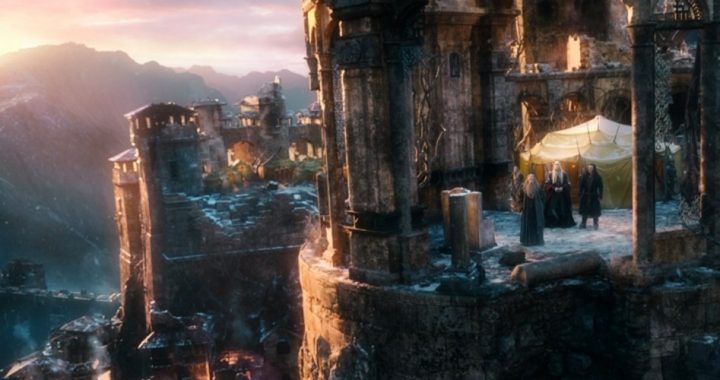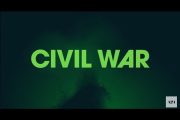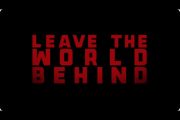
Thirteen long years since a previously obscure New Zealand movie director rocketed to international celebrity with the release of The Lord of the Rings: The Fellowship of the Ring, Peter Jackson and his path-breaking team of CGI wizards are bidding a fond farewell to Middle Earth with the third and final installment of the Hobbit trilogy, The Battle of the Five Armies. While most diehard Tolkien fans would agree that Peter Jackson never consistently captured the full depth and tone of Tolkien’s twin epic fantasy masterpieces, The Battle of the Five Armies, while perhaps 15 minutes too long, is nevertheless one of Jackson’s finest efforts.
Tolkien himself, who died in 1973, long before CGI technology came to Hollywood, always regarded his magnum opus, The Lord of the Rings, as unfilmable, and not only because of the technical challenges in portraying the set-piece battles, monsters, and magic. Tolkien’s high fantasy trilogy is fantastically complex and multilayered, relying as much upon the voluminous appendices that filled in an epochal backstory — often referred to without explanation in the main narrative — as upon the multilingual narrative itself (a number of passages in languages of Tolkien’s own creation appear without translation). Where and what was Angmar, for example, and who is Morgoth? The former was a northern kingdom that came to be ruled by a dread despot — the “Witch King” — who eventually became the leader of the nine Ringwraiths who menace the Fellowship in Lord of the Rings, while the latter is the evil Dark Lord and the master of Sauron who formed the demonic Balrogs (one of which attacks the Fellowship in a dramatic scene in the mines of Moria). But none of this — and much else besides — is actually explained in the text of LOTR; instead, the patient reader must pore over the appendices for enlightenment. All these challenges notwithstanding, Jackson and his team did a more than serviceable job bringing LOTR — most of its Tolkienesque complexity intact — to the big screen.
There were problems, to be sure. While Jackson, a devotee of zombies and other fixtures in the horror genre, clearly relished creating the menacing creatures — trolls, orcs, ringwraiths, balrogs, undead warriors, and so forth — that hedge up the way for the heroes, he and his team were rather less attentive to those portions of the story that were intended to be uplifting and redemptive. Jackson’s characters sometimes speak more like tawdry modern comedians than epic heroes (Aragorn’s exhortation, “Let’s hunt some orc!” and the numerous jokes about dwarf physiognomy come to mind). As a result, LOTR often has a tone more akin to a highbrow horror film than a high fantasy epic exploring timeless themes such as loyalty and the corrupting characteristics of power. Overall, though, Jackson’s flawed but overpowering trilogy is likely to be the best — indeed, the only — film adaptation of LOTR that we are ever likely to see.
The Hobbit, by contrast, presented none of the difficulties of LOTR. Barely 300 pages in length, The Hobbit, first published in 1937 under the cumbersome title The Hobbit, or There and Back Again, is closer to a children’s fairytale than a true piece of epic fantasy. Many of the beings and creatures found in LOTR appear first in The Hobbit, but with few of the mythic details. Gandalf, for example, is merely an inscrutable wizard very much in the mold of Merlin; we do not learn until LOTR (in the appendices, no less!) that he is actually one of the Istari, a group from the race of semi-divine beings (Maiar) who were sent to Middle Earth by the semi-divine Valar to aid the elves and mortal men in the struggle against Sauron. We meet elves in The Hobbit, including Elrond and his abode at Rivendell, but learn nothing of their impending departure from Middle Earth which forms a melancholy backdrop in LOTR. The Necromancer (who we learn in LOTR is actually Sauron, the dark lord) is mentioned in The Hobbit, but he plays no role in the direct story, and there is no hint that the goblins, dragons, trolls, and other evildoers are acting at his behest. Finally, of course, we are introduced to the One Ring and its owner, Gollum, but The Hobbit gives no hint as to the ring’s true nature nor of Gollum’s elaborate backstory (he was once a hobbit, it seems, whom the ring transformed into a sort of subterranean ghoul). In truth, much of that backstory was developed later; it does not appear that, when Tolkien wrote The Hobbit, the magic ring Bilbo acquired was intended as anything other than an interesting bauble that helped out in times of need. That it was in fact evil was never suggested.
Of course, Bilbo’s ring is the veritable “MacGuffin” of LOTR, and, since the more elaborate trilogy had been filmed already, Jackson’s version of The Hobbit needed to portray characters and plot points in far greater detail than Tolkien’s novel in order to maintain consistency with the film version of LOTR.
Characters that do not appear in the book version of The Hobbit are accordingly brought into the filmed version of The Hobbit; Saruman, Galadriel, Legolas, and Frodo — not to mention Sauron and the Ringwraiths — all put in more than cameo appearances. The evil nature of Bilbo’s ring is more than hinted at, and the impending exodus of the elves is discussed. A large part of the storyline of the three Hobbit films is actually taken from the appendices of LOTR, not from The Hobbit itself. It is in the appendices that we learn, for example, that Gandalf — and the other members of the “Council of the Wise” that included Saruman, Elrond, and Galadriel — discovered that Sauron was lurking in a citadel in Mirkwood and teamed up to drive him out. None of this is hinted at in The Hobbit, but is shown in the film thanks to Tolkien’s subsequently conceived backstory. The one-armed white orc Azog who is Thorin’s nemesis in The Hobbit film trilogy is also mentioned in the LOTR appendices, although Tolkien had him dying in battle long before the events of The Hobbit. The orc Bolg (Azog’s formidable first lieutenant in the film) is mentioned in The Hobbit, but does not appear as a character. And, as nearly every Hobbit habitué knows, the elf-maiden Tauriel is pure Jacksonian fabrication.
Many LOTR fans questioned the wisdom of expanding The Hobbit into three more-than-feature-length movies, but in the end, Jackson’s decision appears to have been vindicated. LOTR was an exceedingly tough act to follow, and a single lean film for The Hobbit probably would have come across as anticlimactic on the big screen. For the most part, the three Hobbit films, though a tad overlong, were faithful both to the mood and the content of the source material (including the material from the appendices of LOTR) — far more faithful, in fact, than the film trilogy LOTR was.
This is especially true of The Battle of the Five Armies, which opens with the destruction of Lake-town by the dragon Smaug. With the exception of the ignominious death of the town’s unctuous Master (who survives and helps in the rebuilding in the book version), the movie’s fiery overture follows Tolkien’s narrative closely. The same is true of much of the ensuing intrigue amongst dwarves, men, elves, and orcs for control of the treasure hoard under the Lonely Mountain, which culminates in the eponymous battle. Large portions of dialogue are adapted closely from the book, and the ending is Tolkien’s. Even the novel monsters that crop up in the climactic battle — were-worms and giant bats — are mentioned in the book (although the former are little more than a fanciful figure of speech in the opening chapter).
And there is none of Jackson’s trademark irreverent humor, in this final installation at least. The Battle of the Five Armies is all business from start to finish, with little wasted film time other than a few lengthy battle sequences. Most of the actors deliver fine, nuanced performances — rare in the fantasy genre. In this film, we truly feel the importance of the stakes, and a battle that is summarized in a few short pages at the end of the book becomes a cinematic Götterdämmerung every bit as compelling as the best battles in LOTR. Indeed, future generations who (as with the Star Wars films) choose to watch Jackson’s two trilogies in the order that Tolkien told them will find The Battle of the Five Armies a more than adequate prelude for the greater story yet to come.
Tolkien, an Oxford philologist and devout Catholic who helped convert his friend and fellow fantasy author C.S. Lewis to Christianity, was never merely interested in telling a good story. The Hobbit, like Lord of the Rings, is suffused with Germanic mythology, one of Tolkien’s areas of expertise. The names of the dwarfs and Gandalf are taken from the Völuspa (the first poem of the Norse Poetic Edda), while the character Smaug closely resembles a similar dragon in the Anglo-Saxon tale Beowulf.
Tolkien (along with a number of other fantasy authors, including Madeleine L’Engle, C.S. Lewis, Lewis Carroll, and E. Nesbit) was strongly influenced by 19th-century fantasy writer George MacDonald, a Christian minister whose fairy tale The Princess and the Goblin is today unfortunately nearly forgotten. It was MacDonald who appears to have been the originator of the idea that a fairy-tale or fantasy setting was the ideal milieu for Christian-themed storytelling. Unlike C.S. Lewis, however, Tolkien was never comfortable with allegorical story-telling; instead, he chose Christian themes (like The Hobbit’s exploration of the corrupting power of wealth) in settings that resemble medieval Christian Europe (minus the cathedrals and monasteries). The Christian character of Tolkien’s writings is particularly evident in contrast with the works of most of his modern would-be imitators (like Robert Jordan and Terry Goodkind), whose epic fantasy is typically suffused with sensuality, diabolism, and nihilistic violence and intrigue.
The Hobbit: The Battle of the Five Armies is a fitting conclusion to Jackson’s six-movie Tolkien extravaganza. Where Jackson faltered from time to time in trying to capture the magisterial sweep of Tolkien’s grand saga of Middle Earth and the Ring of Power, The Battle of Five Armies very seldom falls short of Tolkien’s standard. Jackson himself has expressed no interest in becoming Hollywood’s next great go-to blockbuster director because, as he recently explained in an interview, he has no interest in superheroes. Ardent Tolkien fans can only wonder whether he will at some time revisit Middle Earth to bring more of Tolkien’s considerable oeuvre to life.



